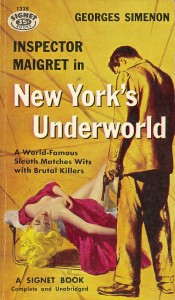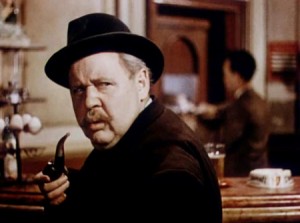 I’m not particularly obsessive by nature, but I do have a very orderly mind, a trait that Mrs. T alternately regards as endearing and exasperating. Hence I was delighted to learn that Penguin has embarked on a uniform paperback edition of Georges Simenon’s seventy-five Maigret novels, all of which will be freshly translated and published in chronological order.
I’m not particularly obsessive by nature, but I do have a very orderly mind, a trait that Mrs. T alternately regards as endearing and exasperating. Hence I was delighted to learn that Penguin has embarked on a uniform paperback edition of Georges Simenon’s seventy-five Maigret novels, all of which will be freshly translated and published in chronological order.
I’ve dipped a toe into the Maigret novels on more than one occasion, and I’ve also read and liked (if that’s the word) a few of Simenon’s shockingly black romans durs, of which New York Review Books has lately reprinted a selection. In addition, I’ve read Patrick Marnham’s The Man Who Wasn’t Maigret: A Portrait of Georges Simenon, a highly readable biography of a vain, opportunistic man who by all accounts appears to have been a singularly unattractive character.
I know enough of Simenon’s work, in short, to be impressed by it, and in particular to understand the enduring appeal of the Maigret novels and their principal character, which Julian Symons aptly summarized in Bloody Murder: From the Detective Story to the Crime Novel, his justly admired 1972 study of the mystery story and its close relations:
The Maigret stories stand quite on their own in crime fiction, bearing little relation to most of the other work done in the field. (Simenon is not much interested in crime stories, and has read few of them.) The bases of the stories are often slight, almost anecdotal. There are no great feats of ratiocination in them, and the problems they present are human as much as they are criminal. The ambience of the stories is wonderfully real, the characters are true and often memorable, yet we are not often emotionally moved by them. Maigret’s detached sympathy becomes our own, and like him we do not care to dig too deeply into the roots of crime, we are ready to move on to another case. Simenon is an undoubted master of the crime story, but his mastery rests primarily in the creation of Jules Maigret….He is one of the most completely realized characters in all modern fiction.
Why, then, haven’t I read more Maigret novels? In part because there are so many of them, making it hard to know where to dive in—but also because they’ve been reprinted virtually at random over the years. Because I have an orderly mind, I’m reflexively disinclined to fish at random in so monstrously large an oeuvre. I like to know where to start, and I like, when possible, to begin at the beginning and proceed from there.
 Heretofore I couldn’t do that without going to a great deal of trouble, but Penguin has now simplified the task, and I plan to get started during our visit to Stonington by reading the first Maigret novel, Pietr-le-Letton, originally published in 1931, which is variously known in English as The Strange Case of Peter the Lett and Maigret and the Enigmatic Lett but which David Bellos has now correctly translated as Pietr the Latvian.
Heretofore I couldn’t do that without going to a great deal of trouble, but Penguin has now simplified the task, and I plan to get started during our visit to Stonington by reading the first Maigret novel, Pietr-le-Letton, originally published in 1931, which is variously known in English as The Strange Case of Peter the Lett and Maigret and the Enigmatic Lett but which David Bellos has now correctly translated as Pietr the Latvian.
And what will I gain by beginning at the beginning? I can’t say yet. Very possibly nothing. But that’s my usual way of doing things, and since you can’t consume all of the art in the world simultaneously, I find it as good a way as any to go about accumulating aesthetic experience without falling victim to the meaningless randomness that is the curse of autodidacticism. You can chew through whole shelves of books without becoming educated in the process. On the other hand, the prig with a too-orderly mind needlessly deprives himself of valuable experience, and while I try to strike a happy medium between these two extremes, I have no doubt that I tend to err on the former side.
Perhaps it would have been better for me, spiritually speaking, to pick five Maigret novels out of a hat and read them at a single go. But I didn’t, and now, at the age of fifty-eight, I’m about to find out what I’ve been missing all these years. I’ll keep you posted.
* * *
The Man on the Eiffel Tower, a 1949 film starring and directed by Burgess Meredith in which Charles Laughton plays Inspector Maigret. The film was shot on location in Paris:


